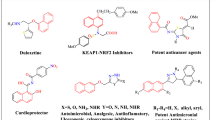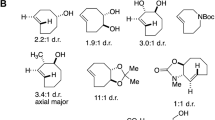Abstract
This work reports the execution of Ecofriendly methods for the synthesis of Ribociclib precursor. Hazardous solvent free methodologies were optimized by using non hazardous and renewable solvents such as EtOH and DMSO. Highly abundant and biologically relavent Zinc metal was employed for Hydrodechlorination reaction along with Recommended solvent EtOH. DMAP catalyzed Ester hydrolysis reaction was performed using recommended solvent EtOH instead of MeOH. Amidation reaction was optimized using DMSO solvent instead of hazardous solvents such as DMF or NMP.
Graphical Abstract




Similar content being viewed by others
References
Lakshmi Praveen P (2021) Nematic and smectic bithiophenes for UV sensing mechanism: comparative calculations on different homologues. J Mol Liq 341(1):114724 (1–6)
Das P, Lakshmi Praveen P (2021) Structure and phase behaviour of alkoxy benzoic acids in DMSO for thermodynamic applications: theoretical investigation. J Mol Struct 1233:130137 (1–6)
Gabrielle VC, Schmitz S, Cédric VM, Xavier C, Antonella M, Sébastien PR, Pierre PR, Didier V, Jean PM (2021) Preclinical evaluation of the association of the cyclin-dependent kinase 4/6 inhibitor, Ribociclib, and cetuximab in squamous cell carcinoma of the head and neck. Cancers 13(6):1251 (1–15)
Xuenong X (2016) Process for preparation of Ribociclib intermediate. WO 2016192522. (PCT Int. Appl. (2016))
Laurent P, Andreas H, Jörg S (2016) A two-step continuous-flow procedure towards Ribociclib. J Flow Chem 6(3):198–201
Maria B, Christopher TB, Shivang D, Sunkyu K, Jianguo M, Josh M, Hong Z (2011) Combination comprising a cyclin dependent kinase 4 or cyclin dependent kinase (cdk4/6) inhibitor and an Mtor inhibitor for treating cancer. WO 2011130232. (PCT Int. Appl. (2011))
Gilbert B, Christopher TB, Clinton AB, Miles SC, Claudio D, Guo H, Ying H, Steven H, Yue L, Yipin L (2010) Preparation of pyrrolopyrimidine compounds as CDK inhibitors. WO 2010020675. (PCT Int. Appl.)
Linghao C (2017) Process for synthesis of Ribociclib. Assignee Qingdao Chenda Biotechnology Co., Ltd., Peop. Rep. China. CN 106928236 A (2017)
Sarbjot SS, Govind S, Saswata L, Maneesh KP, Raj NT, Sonu S, Sachin M, Heena D, Walter C (2019) An improved process for the preparation of Ribociclib and its salts. WO 2019082143 A1
Ke W, Wei H, Lei P, Longlin W, Guangding J, Fan Y (2019) Method for preparing Ribociclib. Peop. Rep. China. CN 109400612 A
Fergal PB, Saimeng J, Giulia P, Tabitha HMP, James HC, Thomas JF, Andrew JH, Robert McElroy C, James S (2016) Tools and techniques for solvent selection: green solvent selection guides. Sustain Chem Process 4:7 (1–24)
Peddireddy SR, Kottur MK, Srinivas O, Bhaskar K, Shirshendu DG (2018) Process for preparation of Ribociclib and its acid addition salts. WO 2018051280. (PCT Int. Appl. (2018))
John VC, Guang-Pei C, Baoqing G, Kapa, Prasad KK, Vishal S (2016) Salt(s) of 7-cyclopentyl-2-(5-piperazin-1-yl-pyridin-2-ylamino)-7H-pyrrolo[2,3-d]pyrimidine-6-carboxylic acid dimethylamide and processes of making thereof. US 20160039832. (U.S. Pat. Appl. Publ. (2016))
John VC, Guang-Pei C, Baoqing G, Kapa, Prasad KK, Vishal S (2016) Salt(s) of 7-cyclopentyl-2-(5- piperazin-1-yl-pyridin-2-ylamino)-7H-pyrrolo[2,3-d]pyrimidine-6-carboxylic acid dimethylamide and processes of making thereof. US 20120115878. (U.S. Pat. Appl. Publ. (2012))
Paul TA, John CW (1998) Green chemistry: theory and practive. Oxford University Press, Oxford, New York
Jensen KF, Rogers L (2019) Continuous manufacturing—the green chemistry promise? Green Chem 21:3481–3498. https://doi.org/10.1039/C9GC00773C
Allu U, Manchikanti Mc, Brahmeswararao Mvn, Ganesh V, D SR (Communicated) Green cheimal principles based regioselective functionalization of 2,4,6-trichloropyrimidine-5-carbaldehyde: application in the synthesis of new pyrimidines and pyrrolopyrimidine. J Serb Chem Soc
Ramakrishna DS (2021) Wadsworth Emmons cyclopropanation mediated diastereoselective Syntheses of α epoxy- trans-disubstituted cyclopropane and α-hydroxy-trans-disubstituted cyclopropane. Chem Data Collect 32:100667 (1–6)
Ramakrishna DS (2021) One pot synthesis of chiral secondary alcohols using noyori asymmetric transfer hydrogenation and Williamson monoetherification: Application in the diastereoselective syntheses of Cis cyclopropyl containing molecules. Chem Data Collect 33:100685 (1–8)
Gullapalli K, Duggirala R, Kondapalli S (2010) A concise enantioselective total synthesis of (+)-epi-muricatacin, using asymmetric hydrogenation/intramolecular iodoetherification as key steps. Tetrahedron Asymmetry 21(5):544–548
Ramakrishna DS, Ankita P (2021) A concise review on the stereoselective synthesis of chiral a-bisamides using stereoselective Ugi-type reaction. ARKIVOC 2021(part ix):1–41
Gullapalli K, Kadivendi S, Duggirala SR, Naresh P, Balasubramanian S, Jagadeesh B (2008) Highly enantioselective carbon–carbon bond formation by Cu-catalyzed asymmetric [2,3]-sigmatropic rearrangement: application to the syntheses of seven-membered oxacycles and six-membered carbocycles. Chem Commun 2008:5324
Ramakrishna DS (2022) Preparation of novel chiral α-diazocarbonyl compounds using Regitz’s methodology. Org Prep Proced Int. https://doi.org/10.1080/00304948.2021.2010466
Christoph S, Martin R (1998) Hydrodechlorination and hydrogenation of aromatic compounds over palladium on alumina in hydrogen-saturated water. Appl Catal B 18:215–221
Jose LB, Gloria DA (2011) Effect of the functional group on the hydrodechlorination of chlorinated aromatic compounds over Pd, Ru, and Rh supported on carbon. Ind Eng Chem Res 50(5):2678–2682
Yuji U, Uatsuo M (2006) Catalytic dechlorination of aromatic chlorides with Pd/C catalyst in alkaline 2-propanol: activity enhancement by the addition of methanol. React Kinet Catal Lett 89(2):341–347
Ariane A, Jean-Jacques B, Pierre L, Denis N, Denis S (2001) Regioselective dechlorination of 2,3-dichloronitrobenzene into 3-chloronitrobenzene and regioselective dechlorination–hydrogenation into 3-chloroaniline. Tetrahedron Lett 42(12):2301–2303
Maria M, Luisa MG (2021) Progress in catalytic hydrodechlorination. Catalysts 1(2):272 (1–2)
Jinhui X, Jilei C, Xiangyang W, Han W, Xiaona Y, Xinxin T, Ren WT, Rong Z, Edwin KLY, Jie W (2021) Unveiling extreme photoreduction potentials of donor–acceptor Cyanoarenes to access aryl radicals from aryl chlorides. J Am Chem Soc 143(33):13266–13273
Kim Y-H, Carraway ER (2003) Dechlorination of chlorinated phenols by zero valent zinc. Environ Technol 24(12):1455–1463
Das P, Lakshmi Praveen P (2019) Solvent polarity and chian length effects in thermotropic mesophase formation process: comparative quantum and thermodynamic analysis. J Mol Liq 288(1):111029 (1–7)
Das P, Lakshmi Praveen P (2020) Theoretical investigation on absorption spectral profile of tetrazole liquid crystals: hexyl, nonyl end groups and solvent effects. IOP Conf Ser 798(1):012041 (1–9)
Lakshmi Praveen P, Ojha DP (2014) Photosensitivity, substituent and solvent-induced shifts in UV-visible absorption bands of naphthylester liquid crystals: a comparative theoretical approach. Liq Cryst 41(6):871–882
Yaochun Z (2020) Method for synthesizing Ribociclib intermediate product and intermediate compound thereof. Faming Zhuanli Shenqing 111100128
Guilermo AM (2018) Preparation of thienopyranones and furanopyranones as kinase, bromodomain, and checkpoint inhibitors. PCT Int Appl, 2018140730
Thiriveedhi A (2019) An improved process for the preparation of Ribociclib succinate and its novel crystalline forms thereof. Indian Pat Appl, 201841002392
Yaochun Z (2020) Method for synthesizing Ribociclib intermediate product and intermediate compound thereof. Faming Zhuanli Shenqing, 111100128
Yu, Wei Y, Yiping Z (2018) Intermediate of Ribociclib, its preparation and application for preparation of Ribociclib. Faming Zhuanli Shenqing, 108586356
Yu, Wei Y, Huaizhi J (2017) Novel method for synthesizing Ribociclib key intermediate. Faming Zhuanli Shenqing, 106478641
Wang, Yihan W, Qingfeng X (2017) Substituted pyrrolopyrimidine compound as CDK inhibitor and its preparation. PCT Int Appl, 2017211245
Guangming Y (2019) Preparation of 2-chloro-7-cyclopentyl-N,N,dimethyl-7H-pyrrolo[2,3-d]pyrimidine-6-formamide as key intermediate of CDK4/6 double inhibitor. Faming Zhuanli Shenqing, 110016024
Leilei W (2017) Concise synthesis of pyrrolo[2,3-d]pyrimidine derivatives via the Cu-catalyzed coupling reaction. Green Chem Lett Rev 10(1):42–47
Gilbert B (2010) Preparation of pyrrolopyrimidine compounds as CDK inhibitors. PCT Int Appl, 2010020675
Ping W, Suwei D, John AB, Karthik I, Steven DT, Qiang Z, Ronald CH, JaeHung S, Malcolm ASM, Samuel JD (2012) Erythropoietin as a single glycoform. Angew Chem Int Ed 51:1–10
Friederike R, Mafalda B, Marina L, Marleen vO, Ben LF, Jan MvD, Wiktor S (2020) A facile and reproducible synthesis of near-infrared fluorescent conjugates with small targeting molecules for microbial infection imaging. ACS Omega 5:22071–22080
Marco TS, Lee TB, Helen FS, Tom DS (2019) A green chemistry perspective on catalytic amide bond formation. Nat Catal 10(2):10–17
Giovanni NR, Anna M, Domenica M, Enrico MB, Carlo P (2012) Synthesis and aggregation properties of a novel enzymatically resistant nucleoamino acid. Amino Acids 43(4):1465–1470
Puneet KG, Mohd KH, Mohd A, Ruchir K, Rohit M, Sanjeev KS, Kanchan H (2014) A metal-free tandem approach to prepare structurally diverse N-heterocycles: synthesis of 1,2,4-oxadiazoles and pyrimidinones. New J Chem 38:3062–3070
Mireia M, Laura M, Carlos A, Elaine A (2013) Novel epoxy coating based on DMSO as a green solvent, reducing drastically the volatile organic compound content and using conducting polymers as a nontoxic anticorrosive pigment. ACS Sustain Chem Eng 1(12):1609–1618
Denis P, Andy W, John H, Helen S, Robert McElroy C, Sarah A, Peter JD (2015) CHEM21 selection guide of classical- and less classical-solvents. Green Chem 18:288–296
Denis P, Olivier P, Hans-Wolfram F, Sylvie L, Véronique D, Pascal I, Eberhard G, Thomas S, Stéphane R, Paul C, Patrik H (2013) Sanofi’s solvent selection guide: a step toward more sustainable processes. Org Process Res Dev 17:1517–1525
Iwona S, Yogesh B, Andrew GL (2011) Environmentally friendly route for the preparation of solvent resistant polyimide nanofiltration membranes. Green Chem 13:162–168
Hari KA, Hariprasad K, Graciela A, Robert S, Dominique S, Jan B, Lijia Y, Mahesh KL (2017) Facile functionalization at the C4 position of pyrimidine nucleosides via amide group activation with (benzotriazol-1-yloxy)tris(dimethylamino)phosphonium hexafluorophosphate (BOP) and biological evaluations of the products. Org Biomol Chem 15:1130–1139
William MN (2003) Green solvents for chemistry: perspectives and practice. Oxford University Press, Oxford
Chris L, Derek AP, Jie JL (2008) Modern organic synthesis in the laboratory. Oxford University Press, Oxford
Acknowledgements
The Start-Up Research Grant [F.20-1(28)/2012 9BSR)] funded by Faculty Research Promotion Schemes (FRPS) of the University Grants Commission (UGC)-India.
Author information
Authors and Affiliations
Corresponding author
Ethics declarations
Conflict of interest
The authors declare no conflict of interest.
Research Involving Human and Animal Participants
This research does not involve experiments on animals or humans.
Additional information
Publisher's Note
Springer Nature remains neutral with regard to jurisdictional claims in published maps and institutional affiliations.
Supplementary Information
Below is the link to the electronic supplementary material.
Rights and permissions
About this article
Cite this article
Udayasri, A., Chandrasekhar, M.M., Brahmeswararao, M.V.N. et al. Ecofriendly Synthesis of Ribociclib Intermediate Using Regioselective Hydrodechlorination and DMAP Catalyzed Ester Hydrolysis. Top Catal 65, 1669–1674 (2022). https://doi.org/10.1007/s11244-022-01602-9
Accepted:
Published:
Issue Date:
DOI: https://doi.org/10.1007/s11244-022-01602-9




